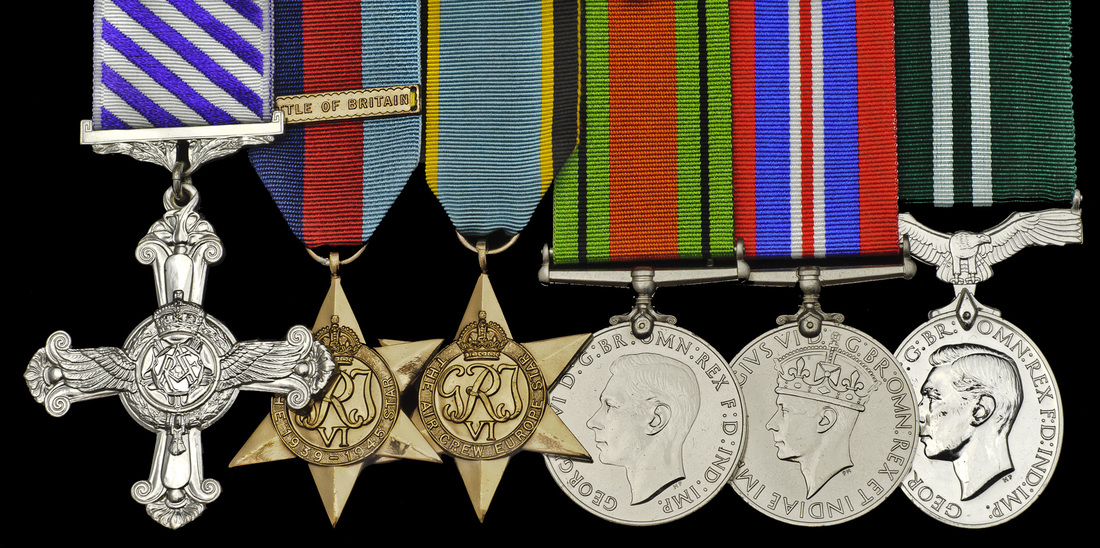
Auction: 15001 - Orders, Decorations, Campaign Medals and Militaria
Lot: 18
A Fine Second War '1943' Night-Fighter's D.F.C. Group of Six to Blenheim and Beaufighter Pilot, Squadron Leader I.K.S. Joll, 604 (County of Middlesex) Squadron, Auxiliary Air Force, Who Was Shot Down Over Holland, 10.5.1940, Before Returning To England Via A Fishing Vessel; He Flew In John 'Cat's Eyes' Cunningham's Flight Throughout The Battle Of Britain, And Claimed 1 Damaged During The Battle. Joll Went On To Be Accredited With At Least 4 Destroyed, And 2 Damaged. On 1.11.1940, Whilst Flying With Jimmy Rawnsley, His Aircraft 'Iced-Up' And Went Into What Looked To Be A Fatal Spin; Joll Managed To Pull Out Of The Spin And Land Safely, But Not Before Rawnsley And Another Crew-Member Had Bailed-Out
a) Distinguished Flying Cross, G.VI.R., reverse dated '1943'
b) 1939-1945 Star, with Battle of Britain Bar
c) Air Crew Europe Star
d) Defence and War Medals
e) Air Efficiency, G.VI.R. (Act. Sqn. Ldr. I.K.S. Joll. A.A.F.), generally very fine, with the following related material:
- Three R.A.F. Pilot's Flying Log Books, covering the period 26.3.1939-26.2.1942; 17.3.1942-30.9.1943 and 3.10.1943-24.7.1948, the first with signatures of 'Cat's Eyes' Cunningham in his capacity as Flight Commander
- Oil painting, 'Squadron Leader I.K.S. Joll DFC, 604 Squadron RAuxAF, Over Chawleigh, Devon, 5th May 1943', signed 'J. Crisp 1993'; with portrait photographic image of recipient in uniform (lot)
D.F.C. London Gazette 26.10.1943 Acting Squadron Leader Ian Kenneth Sefton Joll (09051), Auxiliary Air Force, 604 Squadron
'This officer has undertaken very many sorties and has destroyed 4 enemy aircraft and damaged several more. He is an exceptionally keen and skilful leader, whose personal example has been reflected in the high morale of the flight he commands. In spite of trying experiences, his enthusiasm remains unabated.'
Squadron Leader Ian Kenneth Sefton Joll, D.F.C. (1920-1977), born East Grinstead. He was educated at Hustpierpoint College prior to being employed as a Trainee at Harraps publishers. Aged 18 Joll joined the Auxiliary Air Force, and became a 'part-time' flyer with 604 (County of Middlesex) Squadron, in March 1939. Having been mobilised he carried out pilot training at No. 8 F.T.S., Montrose, October 1939-March 1940. The squadron was predominantly officered by independently wealthy gentlemen, and Joll was expected to behave like one, 'he used to recount with some self-deprecation an incident at his first dinner night in the mess. Sitting at the far end of the table, as befitted the most junior officer in the squadron, and I suspect somewhat overawed by the occasion, the decanter of port ground to a halt in front of my father. After some minutes, the Adjutant leaned forward, fixed him with an icy glare and demanded: "Joll, do you know Smith?" "No," my father replied. "Well you bloody well should do," growled the Adjutant, "he doesn't pass the port either." (extract from typed biography included with lot refers)
Shot Down Over Holland - Back In Time For Tea
604 Squadron was equipped with Blenheims and designated as a night-fighter squadron. Although primarily tasked with trying to perfect night interception with very rudimentary aids, the squadron was also occasionally deployed on other operational sorties. Joll took part in the squadron's first action on 10.5.1940. On the latter date 604 acted as escort for a daylight raid on German transport aircraft on the beach at Wassenar near the Hague. Joll's Log Book gives the following, 'Kenley To Wattisham. Wattisham To Dutch Coast For Raid On Bomber Transports. Stbd. Engine Shot Up. Crashed In Holland. 1 Ju. 52 Destroyed.'
On completion of the raid Joll decided to carry out a low-level strafe of the beach. His Blenheim 'was hit by ground fire in the starboard engine and forced to crash land. In the pre-mission briefing, all pilots had been reminded that under no circumstances were they to allow the ultra-secret interception radar set to fall into enemy hands.
So, although my father managed to land his Blenheim in one piece on the dunes, he now faced a problem. The Blenheim was intact and the fire in starboard engine had been extinguished by the landing. The radar set, screwed into its mountings, was too heavy to move any distance and clearly had to be destroyed. The obvious answer was to set fire to the aircraft but, despite numerous attempts, it refused to catch alight. In exasperation, my father threw caution to the winds and, at some considerable personal danger, fired his Verey pistol into the main fuel tank. Fortunately, that worked.
The next challenge was to get back to England. After a long trek along the beaches they [Joll and his gunner, LAC Pickford] met up with a Dutch fisherman and persuaded him to take them to the English coast; this was just 16 days before the start of the evacuation of the British Expeditionary Force from Dunkirk.
After an uneventful crossing, my father and his navigator arrived in Gravesend where, by chance, my father's parents were then living. Logic, not to say filial courtesy, demanded that they call in on my grandparents for a cup of tea. My grandmother answered the door and promptly fainted. Not ten minutes before she had received a telegram from the Air Ministry stating: "Regret to have to inform you, Pilot Officer Joll missing believed killed." She thought he was a ghost.' (extract from typed biography included with lot refers)
Joll was reunited with his squadron at Manston, and later in the month was engaged in patrolling the Dunkirk beaches by day and night. In July the squadron moved to Middle Wallop. Joll served with 604 Squadron throughout the Battle of Britain, and during this period the squadron was intensively engaged with work on the newly installed A.I. system. Joll flew in 'B' Flight, and was under the command of the newly appointed Flight Commander, John 'Cat's Eyes' Cunningham. The airfield at Middle Wallop was a hive of activity with the Spitfire and Hurricane squadrons fully engaged in the Battle of Britain. By day Joll carried out tests on flights with the "Magic Boxes", whilst at night he was engaged in patrols off the south coast. This was the formative stage of night fighting, carrying on secretly in the background whilst the Battle of Britain raged in the foreground.
At this stage of the war there was little night time activity for the squadron to be involved in, however, they still went out on night patrols. Joll's Log Book gives, 10.10.1940, 'Night Patrol. 'Freelance'. 1 He. III Damaged.' The action took place south of Bournemouth.
A Nasty Experience With Jimmy Rawnsley In Tow
On 1.11.1940 Joll carried out a night patrol with Jimmy Rawnsley as an extra crew member. Rawnsley (Cunningham's gunner) was 'B' Flight's Senior Gunner and paid a close interest in the development of the A.I. equipment. Having sat in on what should have been a routine patrol he received a nasty surprise when Joll's Blenheim iced up at 4,000 feet. Joll's Log Book records that the aircraft went into a spin, with the two crewmen having to bail-out. Joll somehow managed to pull the aircraft up out of the spin and land it safely.
By the end of 1940 the squadron had re-equipped with Beaufighters. Joll appreciated the change of aircraft and the steady improvement of the A.I. After attending a course at No.1 B.A.S. Watchfield in Spring 1941, he returned to the squadron to add to his score. He was partnered with Sergeant A. O'Leary as his A.I. operator, and after a number of chases and contacts with enemy aircraft throughout April they were finally successful 1/2.5.1941, 'Night Patrol Sopley G.C.I. 1 He. III Damaged. A/C Damaged By E/A Fire. Operator Injured. R.T. Useless. Homed 75 Miles To Mother.' (Ibid)
The contact had taken place just north of Swindon. As Joll's Beaufighter had closed in on the Heinkel it managed to get off a burst of return fire. Once again Joll managed to pilot a damaged aircraft home, this time whilst looking after his seriously wounded radar operator.
The Summer of 1941 was to prove far more productive for Joll, and indeed his new radar operator Sergeant R.W. Dalton. Joll's Log Book gives the following additions to his score:
5/6.5.1941, 'Night Patrol. Exminster G.C.I. 1 Ju.88 Destroyed At Chawleigh. Devonshire.'(See watercolour included in lot)
6/7.6.1941, 'Night Patrol. 1 He. III Damaged. Over Poole Harbour. E/A & Wireless P. Hit.' (This was actually a Ju. 88 of 5/KG, that was claimed as Damaged but subsequently confirmed as Destroyed)
8/9.6.1941, 'Night Patrol. He. III Intercepted & Damaged. Jettisoned Bombs Near Botley, Hants & Returned Home.'
4.7.1941, 'Fighter Patrol. Sopley G.C.I. 1 He. III Destroyed At Oakford, Devon.'
The successful partnership came to an end a week later when Joll was posted as an Instructor to No. 54 O.T.U., Church Fenton. Shortly after this Dalton was successfully recommended for an Immediate D.F.M., for which Joll is mentioned in citation.
In April 1942 Joll was posted to the recently reformed 153 Squadron. Based at Ballyhalbert he was tasked with assisting the unit with conversion from Defiants to Beaufighters. He returned to 604 Squadron, at Middle Wallop, in October 1942. He was subsequently promoted Squadron Leader and made Flight Commander. Despite flying numerous patrols there was very little contact due to the Germans focusing on the Russian front. On the 21.9.1943 Joll recorded his final victory, when he Destroyed a Do. 217 60 miles east of Spurn Head. The following month he was awarded the D.F.C.
In November 1943 Joll was posted to Combined Operations Headquarters, 'the organisation led by Lord Louis Mountbatten, where he was involved in planning the parachute landings for D-Day and where he remained until after the invasion of France in June 1944. In later years, his time at Combined Operations gave rise to many anecdotes including the tale of the "Giant Panjandrum". Part of the difficulty of staging a successful landing on the Normandy coast were the large number of beach obstacles that had been erected by the Germans to prevent landing craft from getting to the beaches and tanks from operating on them. Clearly these obstacles would need to be destroyed in the very early stages of the invasion.
The challenge was put to the boffins at Combined Ops and the result was the "Giant Panjandrum": a large wooden cable laying drum filled with high explosive and powered by rockets arranged around its wheels. The idea was that these devices would be launched from landing craft and, powered by the rockets, would trundle through the shallows until they encountered an obstacle. On contact they would blow up, destroying the obstacle and thereby clearing a path on to the beach. A demonstration of this weapon for very senior officers was organised by the Combined Ops staff on the beach at Westward Ho.
With keen anticipation, an assorted crowd of Generals, Admirals and Air Marshals took up their positions on the dunes. A landing craft duly hove into view, the front was lowered and, with a woosh from the rockets, out trundled the "Giant Panjandrum". It headed with faultless precision straight for the nearest obstacle, struck it, failed to explode, turned sharp right, then sharp left and proceeded at increasing speed up the beach and directly for the assembled "brass", who promptly fled for their lives.' (extract from typed biography included with lot refers)
Joll's final posting was to New Delhi, where once again he was employed at the Directorate of Combined Operations. This time he was involved in the planning for the invasion of Burma.
Subject to 20% VAT on Buyer’s Premium. For more information please view Terms and Conditions for Buyers.
Sold for
£7,500




